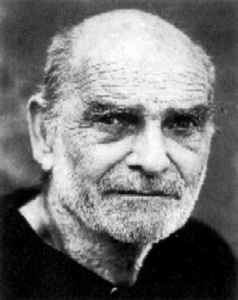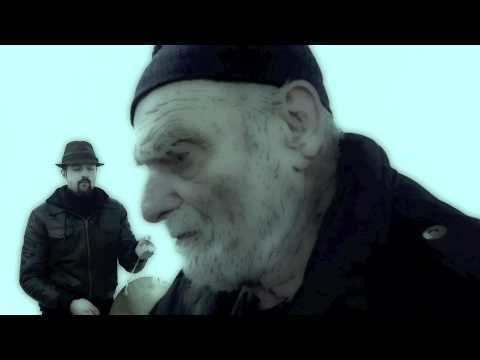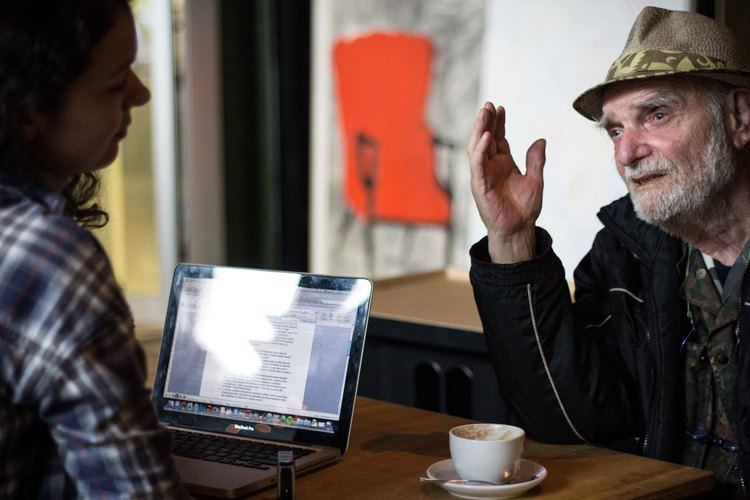Period Minimalism | ||
 | ||
Albums Zuuhh!! Muttie Mum!!, Music to Sleep By, Buzz Off Record labels Tresor, Die Stadt, Pink Bass Edition Similar Dorothy Carter, Rudolf Moser, NU Unruh, Danielle de Picciotto, Jochen Arbeit | ||
Robert "Bob" Rutman (born 15 May 1931) is a German-American visual artist, musician, composer, and instrument builder. Best known for his work with homemade idiophones in his Steel Cello Ensemble, Rutman is regarded as a pioneer of multimedia performance in his mixing of music, sculpture, film, and visual art.
Contents
- Early life and career
- Central Maine Power Music Company
- Steel Cello Ensemble
- Further developments
- Visual art
- Discography
- Recordings as a guest musician
- Live musical collaborations
- Filmography
- Art exhibitions
- Songs
- References

Early life and career

Born in 1931 Berlin, Rutman's mother was a Jewish actress and his father a Bulgarian brownshirt who died in 1933. When the Third Reich came to power, he and his mother fled Germany, moving to Warsaw in 1938 and then to Finland just before Hitler invaded Poland. By way of Sweden, Rutman arrived in England in 1939 where he attended refugee schools throughout the Second World War. After completing his studies in 1950, Rutman moved to New York City in 1950, then had to return to West Germany for military service in 1951.

In 1952 Rutman returned to the U.S. and worked as a traveling salesman in Dallas, Texas, before moving to Mexico City to enroll in art school. He married in Mexico and had a son, Eric. In 1962 Rutman returned to New York where he opened a gallery on Charles Street called "A Fly Can't Bird But A Bird Can Fly", which presented poetry, theater, music, and visual art as multimedia events. Rutman's collaborators included beat poet Philip Lamantia, who mentions Rutman in his poem, "The night is a space of white marble", and sculptor Constance Demby, with whom he made his first sound sculptures in 1966.

In 1967 Demby and Rutman held several happening-style events that mixed sonic, visual, and performance art centered around big sheets of metal that the artists had found. In one piece called "The Thing", Rutman wore a white cardboard box and banged on Demby's sheet-metal creation with "a rock in a sock." In another piece entitled "Space Mass", Rutman projected film upon a piece of curved sheetmetal onto which Demby had welded several steel rods that she played as a percussion instrument. Rutman later remarked, "We thought it would sound good as a xylophone, but it didn't." Rutman would later make adjustments to the sheet metal-and-rod contraption, converting it into a fully playable and tunable idiophone.
Central Maine Power Music Company
In 1967 Rutman moved to Skowhegan, Maine where he built a house in the woods and established another multimedia gallery. Though this gallery sent him into bankruptcy within its four years of operation, it was here that Rutman created the instruments for which he became known. Rutman played these instruments, which were made of large panels of flexible sheet metal affixed with steel strings or freely swinging rods, with a bass or cello bow. He named one of his creations the steel cello, another was called the bow chimes, and he described both as "American Industrial folk instruments".
In 1970 Rutman founded the Central Maine Power Music Company (CMPMC) as his first ensemble to play these sculptures. The CMPMC included Rutman and Demby, with locals Hugh Robbins, Richie Slamm, and Sally Hilmer, plus hammer dulcimerist Dorothy Carter and other occasional guests playing Rutman and Demby's bowed sheet metal creations. Rutman's original concept for the group was to have it be made up entirely of handmade instruments, and the group did feature a configuration of circular sawblades used as percussion. But according to Rutman, his invented instruments ended up serving more as decorations for their performances, as the other members of the group brought in traditional eastern and western instruments, such as drums, electric organ, flute, koto, saxophone, tamboura, and yang chin, as well as electronic musical novelties, including the Moog synthesizer and theremin.
CMPMC performances had a ritualistic quality that incorporated many non-musicians, such as video artist Bill Etra who added visual elements to their shows. The band toured the East Coast, playing at several planetariums in Massachusetts, as well as Lincoln Center, the World Trade Center, and at the United Nations Sculpture Garden in New York. Rutman told a reporter in 1974:
The best way to describe our music is to call it "not music." You see, it often happens that when people hear us play, they say, either in anger or in delight, "That's not music!" It's somewhat akin to the paintings of Jackson Pollock. When the art buffs first saw his work, with the paint drippings and all, they said, "That's not painting."
Steel Cello Ensemble
As Rutman's instruments piqued the interest of aficionados in both visual art and new music composition, his portfolio as an exhibition and concert artist grew. As art pieces, the steel cello and bow chimes toured to galleries and museums where bows were on hand for anyone to play them. Though his instruments were tunable, Rutman had no formal musical training aside from sporadic childhood piano lessons. With neither conventional tuning principles nor systems of notation, it was through alternate means that he began teaching many people to play his instruments. He moved to Boston's then-bohemian Cambridgeport neighborhood and disbanded the CMPMC to found a new, all-steel music group in 1976: the Robert Rutman U.S. Steel Cello Ensemble, whose members included Suzanne Bresler, Jim Van Denakker, and David Zaig. A 1977 press release described the group and its instruments:
The steel cello is 8ft tall and is made from a sheet of stainless steel anchored into a heavy iron stand. It supports one string, which when bowed creates a multitude of resonances, from delicate brittle sounds to deep rich tones. The bow chime, which is shorter, forms a horizontal curve which supports vertical rods, which when bowed produce complementary metallic tones. The Ensemble consists of one steel cello and three bow chimes and together create sounds equal in dynamics to an orchestra.
The Ensemble toured North America, often playing at science museums and art spaces, as well as concert venues. In 1977 they performed at Harvard University's Science Center and at New York's Museum of Modern Art. To further document and promote his work, Rutman founded his own label, Rutdog Records, on which he released albums by his Steel Cello Ensemble. Rutdog also released Dorothy Carter's psych-folk album Waillee Waillee, on which Rutman backs the hammer dulcimerist on his steel cello. Rutman and Carter continued to collaborate for decades thereafter.
In the 1980s Rutman and his instruments began scoring theatrical works by Euripides, Shakespeare, Coleridge, Rilke, Thoreau, and others. In 1980 the Steel Cello Ensemble performed for Peter Sellars' Harvard University stage production of King Lear, and in 1985 worked with Laurie Anderson on Robert Wilson's rendition of Alcestis at the American Repertory Theatre. That same year Rutman was invited to play at prominent venues in the European cities he had lived in as a child, and he gave concerts at the Berlin Atonal, London's Institute of Contemporary Arts, and Warsaw's Palace of Culture and Science. In 1989 Rutman threw himself a farewell party in Cambridge before relocating to his birth city of Berlin where he continues to live and make work.
In an interview given shortly before leaving the U.S., Rutman shared his perspective on his instruments and music:
I see the music as the American industrial. They are the product of our society...indigenous American instruments. They really reflect the sounds of our society, and the engines and drones and stuff like that. The indigenous properties of the instruments have a western harmonic tonality, like a brass horn. They produce this brilliant, harmonic, metallic sound. It's what electronic instruments want to do and really can't in the way that the steel cellos can do. It creates the environment that's both ancient and futuristic at the same time. It spans this whole sense of space and future and past. That's what's inherent in the sound of the instrument.
Further developments
Over the years, Rutman developed an interest in Tibetan meditation and music. He spent five years teaching himself to throat sing in the style of Tibet's Buddhist monks and began to match his instruments low tonalities with his own voice. He also re-incorporated traditional non-western instruments into Steel Cello Ensemble performances and recordings, including the tabla, Tibetan horn, and didgeridoo.
Because of the steel cello's mass, Rutman developed lighter weight instruments for impromptu shows. First came the buzz chime, a triangular wooden drone instrument, which he added to his Steel Cello Ensemble. In the 1990s he satirized his own work by creating the styrophone, a handheld instrument that mimicked the appearance of his bow chimes, but instead of its five protruding brass rods being affixed to steel, they appeared as spindly wires stuck into blocks of styrofoam. Unlike his sheet-metal instruments, which can last indefinitely, each Styrophone is destroyed by the process of playing it. Rutman told an interviewer in 2013:
The styrophone is the exact opposite to the bow chime and the steel cello, which make a very full sound. Instead, the styrophone is like Gänsehaut! It’s the opposite of beauty, it’s like really ugly and I like that.
Throughout the 1990s Rutman continued to score theatre and film, including Wim Wenders' sequel to Wings of Desire and Heiner Goebbels' stage adaptation of Walden. He toured and recorded with German industrial music group Einstürzende Neubauten and also played on albums by Meret Becker, Alexander Hacke and Swans.
Rutman's training of other musicians has also spawned new generations of steel cellists and bow chimers, many of whom have gone on to compose and perform on the instruments. Among these are Klaus Wiese's Nono Orchestra, Wolfram Spyra and Pete Namlook as the duo Virtual Vices, and Mathias Grassow.
Rutman's instruments are in the collection of the Smithsonian Institution. Instruments similar to Rutman's steel cello and bow chimes have continued to appear in Constance Demby's work as "The Whale Sail" and "The Space Bass". Demby maintains that Rutman's instruments are adaptations of her own.
Visual art
In addition to his music and instruments, Rutman continues to produce and exhibit drawings, oil paintings, engravings and wire sculptures, examples of which can be seen on his website. His influence is in the work of Jackson Pollock and abstract impressionism, and he is best known for depicting landscapes, nude figures, Catholic themes, and chairs.
Discography
Recordings as a guest musician
Live musical collaborations
Filmography
Art exhibitions
In addition to displaying his visual artwork at his own concerts, Rutman has had solo exhibitions all over the world.
Songs
Buzz ChimeZuuhh!! Muttie Mum!! · 1998
Buzz OffZuuhh!! Muttie Mum!! · 1998
> 33 Rotations°Music to Sleep By · 1997
